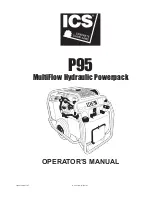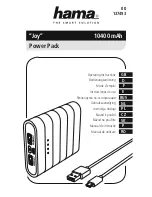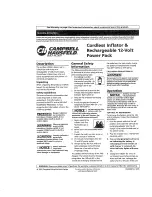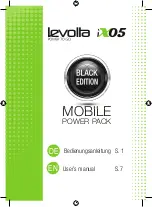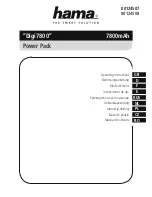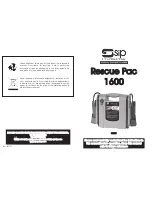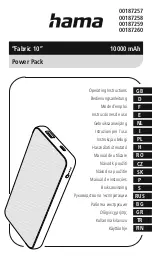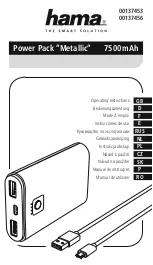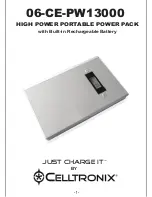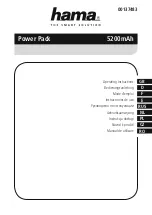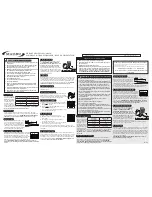
Occupancy Sensor AutoON/Override Power Pack
Cat. No. LCA2292
Load Ratings: 20A, 2400W @ 120V, 60Hz - Incandescent / 20A, 2400VA @ 120V, 60Hz - Fluorescent
20A, 5540VA @ 277V, 60Hz - Fluorescent / 1/2 HP @ 120V - Motor Load / 2 HP @ 240/277V, 60Hz - Motor Load / 0.5A 120V, 1A 30VDC - HVAC Relay
For use with LRM2250, LRM2255, LRM2260, LRM2265, LRM2270,LRM2275, LRM2280 Low Voltage Sensors
INSTALLATION INSTRUCTIONS
WARNINGS AND CAUTIONS:
•
TO AVOID FIRE, SHOCK, OR DEATH; TURN OFF POWER at circuit breaker or fuse and test that power is off before wiring!
• To be installed and/or used in accordance with appropriate electrical codes and regulations.
• If you are unsure about any part of these instructions, consult an electrician.
• Use this device with
copper or copper clad wire only.
•
Disconnect power when servicing fixture or changing lamps.
• Lights Flickering
- Lamp has a bad connection.
- Wires not secured firmly with wire connectors.
• Lights did not turn ON
- Circuit breaker or fuse has tripped.
- Lamp is burned out.
- Lamp Neutral connection is not wired.
- Hold OFF or Manual ON input is active.
- Low Voltage miss wired. Verify wiring pre appropriate diagram.
- Line Voltage miss wired. Verify wiring pre appropriate diagram.
• Lights stay ON
- Constant motion.
To Test: adjust sensor; remove motion source (HVAC, Mask, or
move sensor).
• Lights turn ON too long
- Adjust sensor settings.
• Lights came ON during presentation
- AutoON mode is connected and the time delay expired.
- Increase the sensor time delay or generate more motion during the presentation.
• Lights do not turn OFF with time delay
- Hold ON input is active.
FEATURES
• Title 24 Compliant
• Hold On/ Hold Off capabilities
• Regulated 24VDC, 150mA output current
• Mounts inside Fluorescent Ballast cavity
• Mounts inside or outside Junction Box
• Rated for Plenum spaces
RATINGS
Part Number
HVAC Relay
Power Input
1
Power Output
2
LCA2292
Yes
120-277VAC, 50/60Hz
24VDC, 150mA 3.6W
1
Input voltage tolerance 10%, Frequency tolerance 5%.
2
Output voltage tolerance 15%, Output voltage listed at nominal.
DESCRIPTION
The power pack contains a power supply, a load switching relay and an HVAC relay.
The power supply provides Class 2 low-voltage power for LRM2250, LRM2255,
LRM2260, LRM 2265, LRM2270, LRM2275, and LRM2280 Series Occupancy
Sensors. The relay in the power pack is controlled by the occupancy sensors
connected via the 22 Gauge Blue "occupancy" wire. Multiple occupancy sensors
can be connected to a single power pack in order to fully cover an area. The power
packs include zero cross switching circuitry to minimize inrush current associated with
incandescent and electronic ballasts. This reduces wear and tear on the relay contacts
making the power pack last longer.
Application Notes:
1. When a lighting load exceeds a single power pack’s rating, the load can be split
between multiple power packs. The low voltage occupancy input (Blue wire) and DC
return (Black wires) of the power packs must be connected together for all power
packs to operate together as one. Connect the Blue (occupancy) wires of all power
packs and sensors together. Connect the Black (return) wires of all power packs and
sensors together. Connect the Red (+24VDC) wires of the sensors to the Red wires
of only one power pack. Never connect the Red (+24VDC) wires of two different
power packs together.
2. When more sensors are required than one power pack can supply, multiple power
packs can be used to supply power to the occupancy sensor, but not switch any
load. The primary power pack is the power pack switching the load. The secondary
power packs only provide low voltage power to the occupancy sensor(s). Connect as
many sensors to the primary power pack as possible (see current capacity section
below), by connecting the Red wires of the sensors to the Red wire (+24VDC) of
the primary power pack. Connect the Red wires (+24VDC) of the remaining sensors
to the Red wires of the secondary power pack. Connect the Black (return) wires of
all power packs and all sensors together. Connect the Blue (occupancy) wire of all
sensors together to the Blue wire (occupancy) of the primary power pack. Never
connect the Red (+24VDC) wires of two different power packs together.
FCC COMPLIANCE STATEMENT (LCA2292)
This equipment has been tested and found to comply with the limits for a Class A digital
device, pursuant to part 15 of the FCC Rules. These limits are designed to provide
reasonable protection against harmful interference when the equipment is operated
in a commercial environment. This equipment generates, uses, and can radiate radio
frequency energy and, if not installed and used in accordance with the instruction
manual, may cause harmful interference to radio communications. Operation of this
equipment in a residential area is likely to cause harmful interference in which case the
user will be required to correct the interference at his own expense.
LOW-VOLTAGE CURRENT CAPACITY
INSTALLATION
LCA2292
Total Number of Sensors
≤
150mA
1.
WARNING:
TO AVOID FIRE, SHOCK, OR DEATH;
TURN OFF POWER AT
CIRCUIT BREAKER OR FUSE AND TEST THAT POWER IS OFF BEFORE WIRING!
2. Mount power pack per desired application:
A. To mount outside 4"x4" junction box using 2" EMT nipple, refer to Figure 1. Wire
per instructions
Step 3A and 3B.
B. To mount inside 4"x4" junction box, refer to Figure 2. Wire per instructions Step
3A and 3B.
• Ensure that conduit/cable entry clamp is located in corner of junction box.
• Dress wires to provide enough clearance when device is installed.
CAUTION:
Low-voltage wires must also be dressed so they are separate
from the high voltage (Class I) conductors. Refer to local building codes for the
appropriate installation requirements for the low voltage wiring. Jacketing over the
low-voltage wires may be required to provide appropriate insulation from the high-
voltage wiring.
C. To mount inside ballast cavity of light fixture, refer to Figure 3A. Wire per
instructions
Step 3A and 3B.
CAUTION:
Low-voltage wires must also be dressed so they are separate
from the high voltage (Class I) conductors. Refer to local building codes for the
appropriate installation requirements for the low voltage wiring. Jacketing over the
low-voltage wires may be required to provide appropriate insulation from the high-
voltage wiring.
D. To mount outside ballast cavity of light fixture, refer to Figure 3B. Wire per
instructions
Step 3A and 3B.
3A. Line Voltage Wiring: Remove 5/8" (1.6 cm) of insulation from each circuit conductor.
Make sure that ends of conductors are straight. Connect lead wires from Power Pack
to LINE circuit per appropriate WIRING DIAGRAM as follows: Twist strands of each
lead tightly and, with circuit conductors push firmly into appropriate wire connector.
Screw connectors on clockwise making sure that no bare conductor shows below the
wire connectors. Secure each connector with electrical tape.
3B. Class 2 and HVAC Wiring: Connect Low-Voltage wires from Power Pack to Sensor
per appropriate WIRING DIAGRAM as follows: Twist strands of each lead tightly and,
with circuit conductors, push firmly into appropriate wire connector. Screw connectors
on clockwise making sure that no bare conductor shows below the wire connectors.
Secure each connector with electrical tape.
4. Refer to sensor Installation Instructions for further details.
5. Restore power at circuit breaker or fuse. INSTALLATION IS COMPLETE.
Mounts outside
junction box
Figure 1
Line Voltage Wires
Class 2 Wires
Figure 2
Mounts inside
junction box
Line Voltage Wires
Class 2 Wires
OPERATION
The AutoOn/Override Power Pack can be turned ON and OFF automatically using an
occupancy sensor input, a timer, panel or BAS input, and manually from an optional low
voltage momentary switch.
AUTO ON (See Wiring Diagram):
The occupancy sensor input, Hold ON input and the optional momentary switch input can
all be used to turn the load ON.
When the load is turned OFF using the momentary switch, the power pack does not turn
it ON automatically until after the sensor time delay expires (e.g., presentation mode).
Pressing the momentary switch before the sensor time delay expires turns the load ON.
When the occupancy sensor’s time delay expires, the power pack reverts to AutoON mode
and it turns the load ON with the next input from the occupancy sensor.
MANUAL ON (See Wiring Diagram):
Occupants must press the low voltage momentary switch to turn the load ON.
When the occupancy sensor is the only input keeping the load ON, the load turns OFF
when the sensor time delay expires. If the sensor input re-triggers within 30 seconds after
the load turns OFF, the load turns ON again. After the 30 seconds expire with no sensor
input press the momentary switch to turn the load ON.
LOW VOLTAGE INPUTS
24VDC input wires are provided to control the load relay. The inputs may be used in
combination or individually, depending on the application(s). See wiring diagrams for
connections.
MAINTAINED INPUTS
Occupancy Sensor (Blue) - This input is for occupancy sensor AutoON/AutoOFF.
Applying 24v closes the relay (Occupied). Remove the voltage and the relay opens (Vacant).
Occupancy Sensor (Blue/White) - This input is for occupancy sensor ManualON/AutoOFF.
When the attached occupancy sensor detects motion, no action occurs. A local
momentary switch is required to manually turn the load ON. Then the sensor will turn the
load OFF when the time delay expires.
Hold ON (Yellow) - This input is intended for timer or panel input.
Applying 24VDC closes the relay
and disables other inputs
.
It
can be
overrid
den by the Hold
O
FF
input.
Hold OFF (Orange) – This input is used for timer, panel, BAS or load shed input.
Applying 24VDC opens the relay. Remove the voltage and the relay can accept any other
input. It overrides the Control ON and Hold ON inputs.
Local Switch (Yellow/Orange) – This input is for a low voltage momentary switch.
Applying 24VDC momentary input changes the relay to the opposite state. It overrides the
Control ON, Hold ON and Hold OFF inputs.
• All wires rated at 105
o
C, 600V insulation.
• Class 2 wires are Teflon coated, for plenum applications.
• HVAC wiring is Class 1 and Class 2 rated.
Line Voltage Wires
Class 2 Wires
Line 120-277V
Neutral
Load
Load
Power (24 VDC)
DC Return
Occupancy Auto ON
HVAC Wires
HVAC Common
HVAC NO (Normally Open)
HVAC NC (Normally Closed)
Occupancy Manual ON
Hold ON
Hold OFF
Local Switch Input
Signal Name
Black
White
Blue
Blue
Red
Black
Blue
Green
Brown/White
Brown
Blue/White
Yellow
Orange
Yellow/Orange
Color
18 AWG
18 AWG
14 AWG
14 AWG
22 AWG
22 AWG
22 AWG
22 AWG
22 AWG
22 AWG
22 AWG
22 AWG
22 AWG
22 AWG
Gauge
Wire Designations
TROUBLESHOTING



